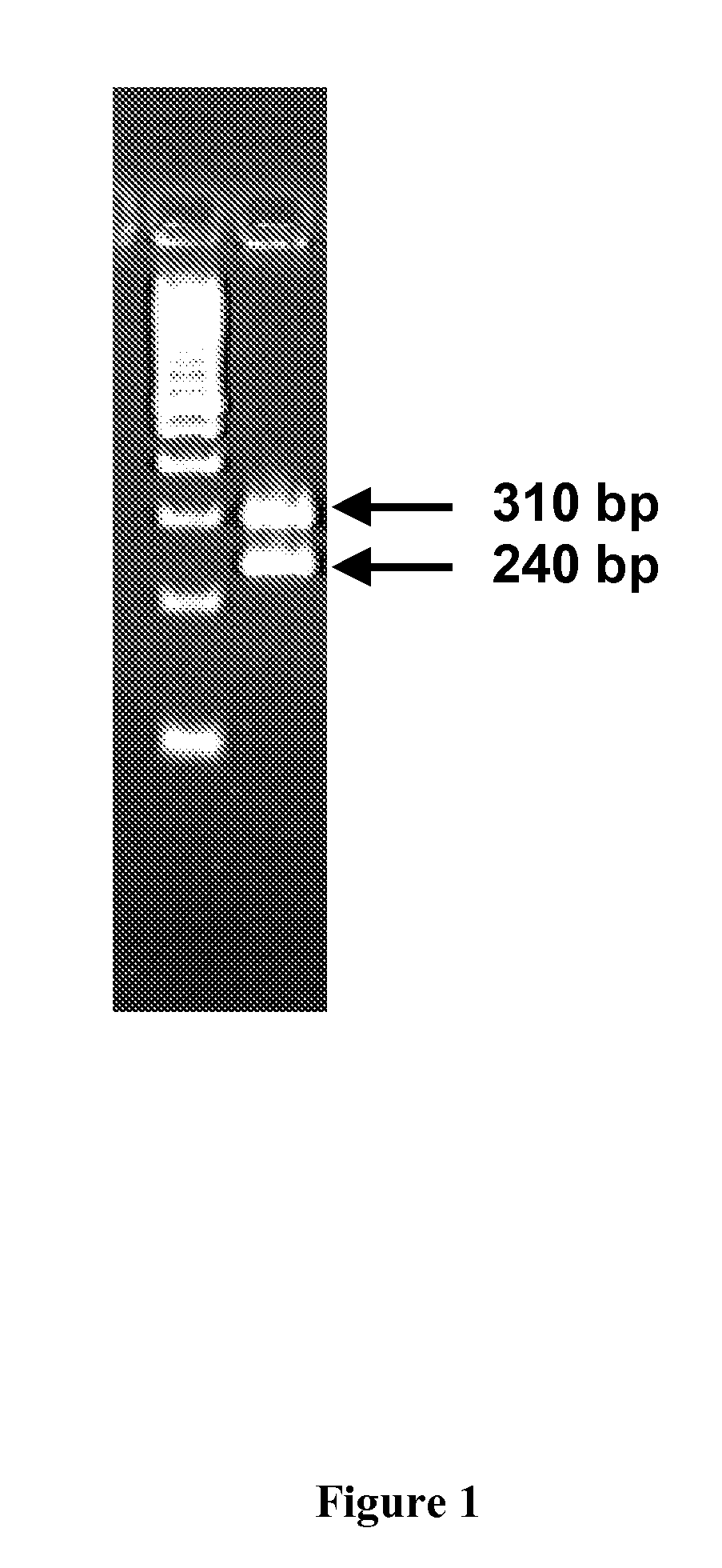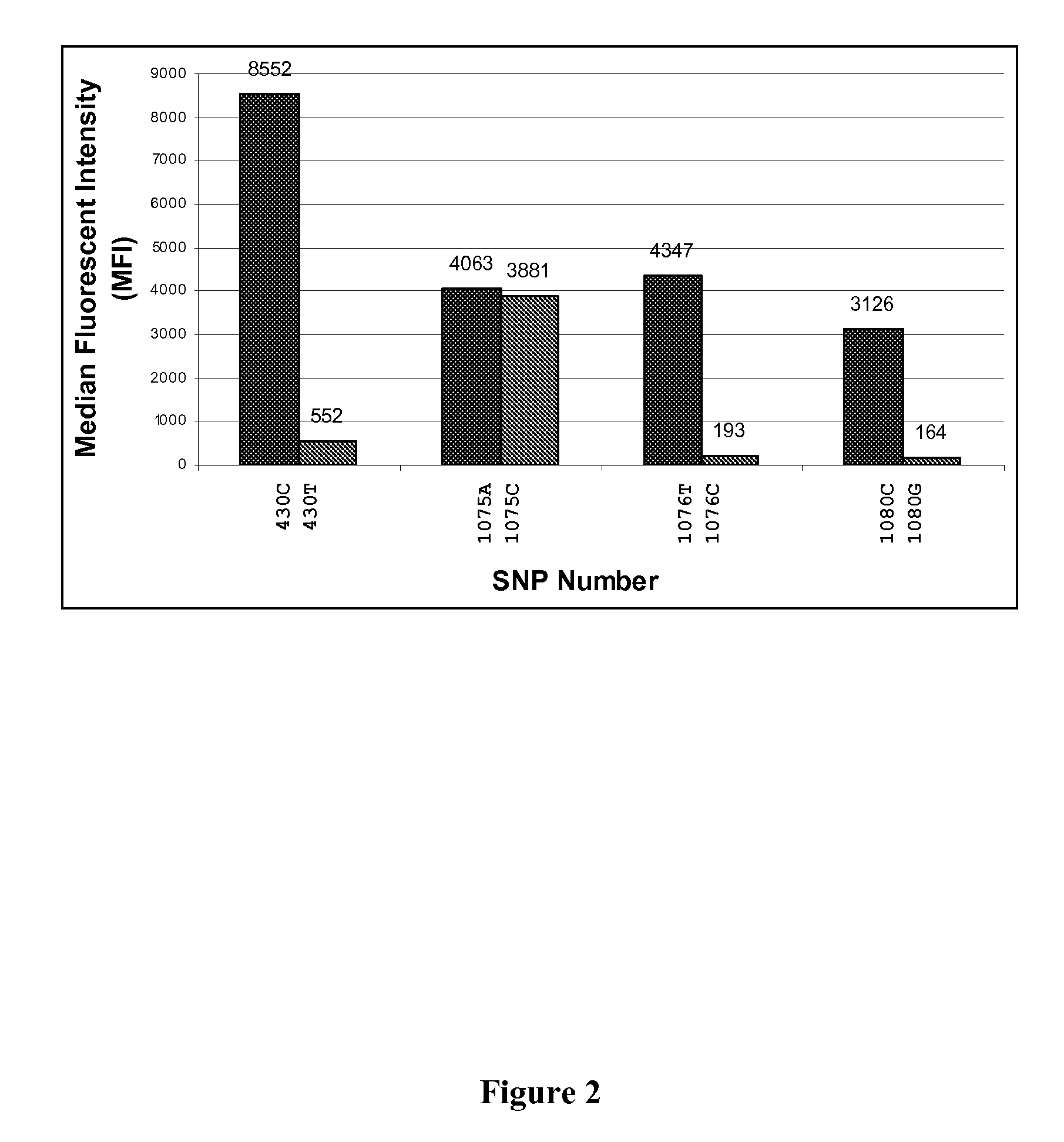Reagents and Methods for Detecting CYP2C9 Polymorphisms
a polymorphism and polymorphism technology, applied in the field of reagents and methods for detecting cyp2c9 polymorphisms, can solve the problems of drug response, undesirable or even toxic side effects of patients, drug work well in some patient populations but not as well in others, etc., to achieve rapid detection, reliable and convenient
- Summary
- Abstract
- Description
- Claims
- Application Information
AI Technical Summary
Benefits of technology
Problems solved by technology
Method used
Image
Examples
example 1
[0181]An assay was carried out in a multiplex format using sets of primers and detection probes described in Table 1 (SEQ ID NOs. 1 to 4) and Table 2 (SEQ ID NOs. 5 through 12).
[0182]Amplification of genomic DNA obtained from an individual was performed using PCR. Amplification products obtained, Amplicon p2 and Amplicon p3, were found to have the correct sizes (i.e., 310 bp and 240 bp, respectively) by agarose gel analysis (See FIG. 1). PCR amplification was followed by Allele-Specific Primer Extension (ASPE) reaction. The allele-specific extension primers used were R35-ASP2WT, R36-ASP2MT, R37-ASP3WT, R43-ASP3MT, R39-ASP4DWT, R40-ASP4DMT, R44-ASP5LDWT, and R42-ASP5LDMT (i.e., inventive ASPE primers described in Table 4).
[0183]ASPE products were then captured onto Luminex beads coupled with orthogonal zipcode sequences of the invention (see Table 3). Performance (i.e., specificity) of the inventive tag and zipcode sequences was tested and the results are shown in FIG. 3.
[0184]The fi...
example 2
[0185]A similar experiment was carried out using a panel of genomic DNA samples from seven patients that includes different available genotypes; and one negative control.
[0186]The results obtained in this experiment are presented in FIG. 4 in one scattered plot per allele (i.e., CYP2C9 *2, CYP2C9 *3, CYP2C9 *4 and CYP2C9 *5). In these plots, values along the Y axis are MFL (mean fluorescence) recorded from the wild-type (WT) probes; values along the X axis are MFL recorded from the mutant probes. Grey zones are no-call regions (i.e., regions from which no conclusion can be drawn). Each small diamond represents one patient.
[0187]Data points that fall in the left hand-side region indicate homozygote wild-type genotypes; data points that fall in the middle region indicate heterozygote genotypes; and data points that fall in the right hand-side region indicate homozygote mutant genotypes. The data point at or near the origin corresponds to the negative control.
example 3
[0188]The ASPE products obtained as described in Example 1 were also detected using a planar waveguide platform. The ASPE reaction mixture was loaded on a PWG chip on which zipcode sequences of the present invention were spotted to specific locations for hybridization. The PWG chip was then washed and read using a PWG reader.
[0189]The results obtained, which are shown in FIG. 5, are in complete concordance with the results obtained using the Luminex system. More specifically, the PWG analysis led to the conclusion that the individual tested is heterozygous for *3 and wild-type for the other polymorphisms.
Other Embodiments
[0190]Other embodiments of the invention will be apparent to those skilled in the art from a consideration of the specification or practice of the invention disclosed herein. It is intended that the specification and examples be considered as exemplary only, with the true scope of the invention being indicated by the following claims.
TABLE 1SEQIDNO.Sequence Name*Seq...
PUM
| Property | Measurement | Unit |
|---|---|---|
| temperature | aaaaa | aaaaa |
| temperature | aaaaa | aaaaa |
| temperature | aaaaa | aaaaa |
Abstract
Description
Claims
Application Information
 Login to View More
Login to View More - R&D
- Intellectual Property
- Life Sciences
- Materials
- Tech Scout
- Unparalleled Data Quality
- Higher Quality Content
- 60% Fewer Hallucinations
Browse by: Latest US Patents, China's latest patents, Technical Efficacy Thesaurus, Application Domain, Technology Topic, Popular Technical Reports.
© 2025 PatSnap. All rights reserved.Legal|Privacy policy|Modern Slavery Act Transparency Statement|Sitemap|About US| Contact US: help@patsnap.com



